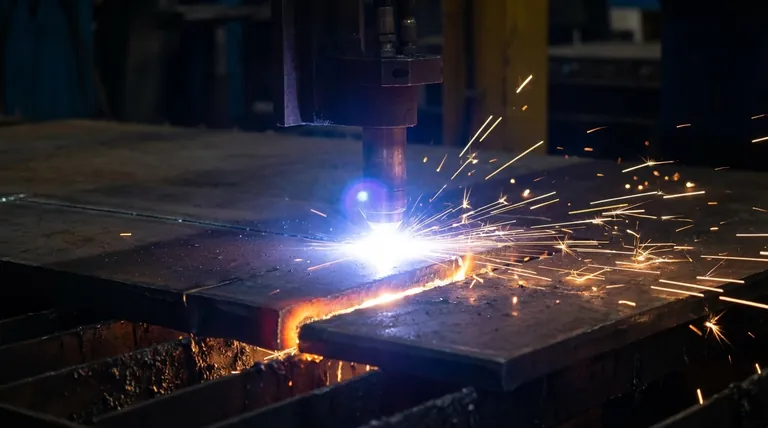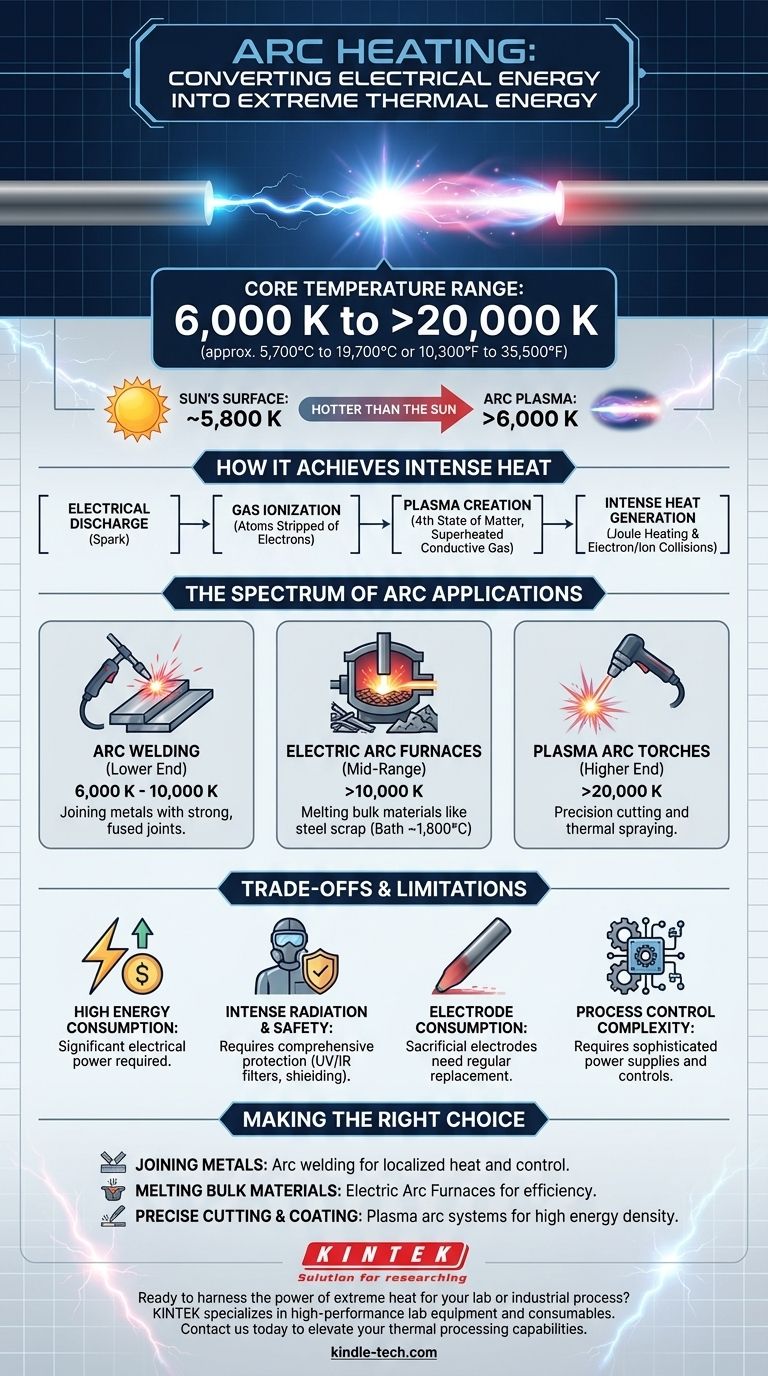At its core, arc heating is a process of converting electrical energy into extreme thermal energy. The temperature of the electric arc plasma itself typically ranges from 6,000 K to over 20,000 K (approximately 5,700°C to 19,700°C or 10,300°F to 35,500°F). This vast range allows it to be adapted for applications from welding common metals to cutting highly resistant alloys.
The critical takeaway is not just the extreme temperature but the ability to concentrate that immense energy. Arc heating's power lies in creating a localized zone of heat far hotter than the sun's surface, enabling industrial processes that are impossible with conventional combustion or resistance heating.

How Arc Heating Achieves Such Extreme Temperatures
To understand the applications of arc heating, you must first grasp the fundamental physics that generate this intense heat. It is a controlled and focused application of a powerful natural phenomenon.
The Principle of the Electric Arc
An electric arc is a sustained electrical discharge, or spark, that flows through a gas. When a sufficient voltage is applied between two electrodes, the gas between them ionizes, meaning its atoms are stripped of electrons.
This process transforms the gas into plasma, often called the fourth state of matter.
What is Plasma?
Plasma is a superheated, electrically conductive gas. It consists of a high-energy mix of free-moving ions and electrons. It is this unique state that allows electricity to flow through what would normally be an insulating gas.
From Electricity to Intense Heat
The immense heat of an arc is generated by two primary mechanisms. First, the plasma has electrical resistance, and as a massive electrical current is forced through it, this resistance creates intense heat (Joule heating).
Second, constant collisions between the high-energy electrons and ions within the plasma release even more thermal energy, sustaining and intensifying the arc's temperature.
The Spectrum of Arc Applications
The specific temperature and configuration of the arc are tailored to the industrial task. The process is not one-size-fits-all; it is a spectrum of controlled power.
Arc Welding (Lower End)
For welding applications, arc temperatures are typically in the range of 6,000 K to 10,000 K. This is more than sufficient to melt the edges of workpieces and a filler metal, creating a molten pool that solidifies into a strong, fused joint.
Electric Arc Furnaces (Mid-Range)
Used for melting scrap steel, Electric Arc Furnaces (EAFs) utilize massive graphite electrodes to generate powerful arcs. The arc plasma can exceed 10,000 K, while the molten steel bath itself reaches temperatures around 1,800°C (approx. 2,100 K). This demonstrates how the arc acts as the heat source to bring a large mass to its melting point.
Plasma Arc Torches (Higher End)
Plasma cutting and spraying systems use a constricted arc, forcing the plasma through a small nozzle at high velocity. This process dramatically increases the energy density and temperature, which can easily exceed 20,000 K. This focused jet of plasma can cleanly sever thick plates of metal with precision.
Understanding the Trade-offs and Limitations
While incredibly powerful, arc heating technology comes with specific operational considerations that are critical for its safe and economical use.
High Energy Consumption
Generating and sustaining an electric arc requires a significant amount of electrical power. This makes it one of the most energy-intensive heating methods, suitable for high-value industrial processes where its unique capabilities are essential.
Intense Radiation and Safety
The extreme temperatures produce intense ultraviolet (UV) and infrared (IR) radiation. This necessitates comprehensive safety measures, including specialized protective clothing, welding masks with UV filters, and physical shielding to protect personnel.
Electrode Consumption
In many arc heating systems, particularly Electric Arc Furnaces, the electrodes are sacrificial. They are consumed during the process and must be regularly replaced, representing a significant operational cost.
Process Control Complexity
Maintaining a stable arc and precisely controlling the heat input requires sophisticated power supplies and control systems. The process is sensitive to factors like electrode distance, gas flow, and the material being processed.
Making the Right Choice for Your Goal
Selecting the right heating technology depends entirely on the material, scale, and desired outcome of your process.
- If your primary focus is joining metals: Arc welding provides the necessary localized heat and control to create strong, fused joints in most common metals.
- If your primary focus is melting bulk materials: Electric Arc Furnaces are the industry standard for efficiently melting large volumes of steel scrap and other high-melting-point alloys.
- If your primary focus is precise cutting or thermal spraying: Plasma arc systems offer the highest temperatures and energy density for high-speed cutting and applying durable surface coatings.
By understanding the principles behind its immense heat, you can effectively leverage arc heating for the most demanding industrial applications.
Summary Table:
| Arc Heating Application | Typical Arc Temperature Range | Key Use Case |
|---|---|---|
| Arc Welding | 6,000 K - 10,000 K | Joining metals with strong, fused joints |
| Electric Arc Furnaces | >10,000 K | Melting bulk materials like steel scrap |
| Plasma Arc Torches | >20,000 K | Precision cutting and thermal spraying |
Ready to harness the power of extreme heat for your lab or industrial process? KINTEK specializes in high-performance lab equipment and consumables, providing the tools you need for welding, melting, and material testing applications. Our expertise ensures you get the right equipment to achieve precise temperature control and efficient operations. Contact us today to discuss how our solutions can elevate your thermal processing capabilities!
Visual Guide

Related Products
- Laboratory Muffle Oven Furnace Bottom Lifting Muffle Furnace
- 1800℃ Muffle Oven Furnace for Laboratory
- 1700℃ Laboratory Quartz Tube Furnace with Alumina Tube Tubular Furnace
- Molybdenum Disilicide (MoSi2) Thermal Elements Electric Furnace Heating Element
- High Temperature Muffle Oven Furnace for Laboratory Debinding and Pre Sintering
People Also Ask
- What is the temperature limit on a muffle furnace? A Guide to Selecting the Right Model
- What is the difference between a crucible and a furnace? Understanding the Heat Source and Container Partnership
- What is the burnout cycle on a furnace? Stop This Destructive Overheating Pattern Now
- What affects the melting point of a substance? Uncover the Key Factors & Forces
- Do different liquids melt at different rates? Unlock the Science of Melting Points and Material Properties



















